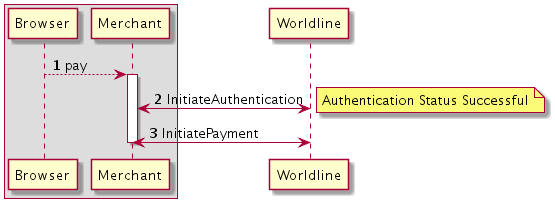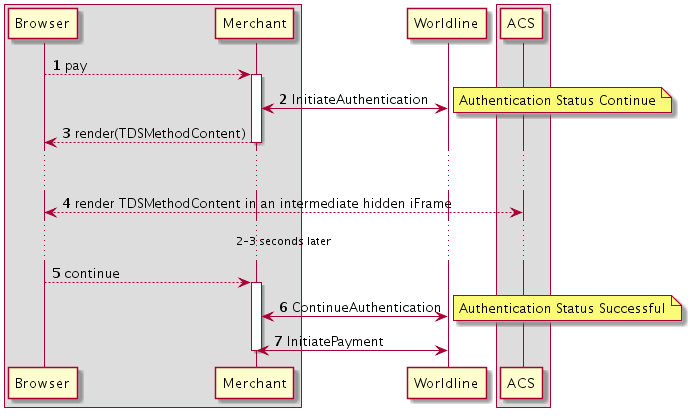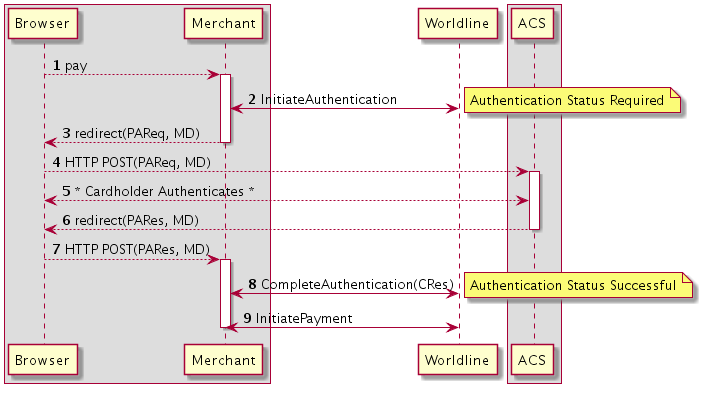What is 2-Step Authentication¶
2-Step Authentication is a generic solution offered by Worldline to provide various implantations of Strong Customer Authentication. Currently, supported authentication methods are 3-D Secure 1.0 and 3-D Secure 2.0.
What is 3-D Secure¶
The 3-D Secure authentication protocol is based on a three-domain model where the Acquirer Domain and Issuer Domain are connected by the Interoperability Domain for the purpose of authenticating a Cardholder during an electronic commerce (e-commerce) transaction or to provide identity verification and account confirmation. EMVCo specifies protocol and core functions of 3-D Secure 2.0. EMVCo is an organization overseen by American Express, Discover, JCB, MasterCard, UnionPay, and Visa.
Worldline clients who implement 3-D Secure benefit by reducing the chargeback risk of transactions and in most cases also shifts the liability for chargeback’s from themselves to the issuing banks.
3-D Secure 2.0 Frictionless¶

- Cardholder checkout.
- Merchant Initiate Authentication to determine whether cardholder authentication is necessary or not.
- Authentication Status equal to SUCCESSFUL indicates that the authentication was successful and that the ThreeDSecureResult contains 3-D Secure data that shall be provided in the Initiate Payment request to be able to claim liability shift.
- Merchant Initiate Payment.
3-D Secure 2.0 Frictionless with 3DS Method Data¶

- Cardholder checkout.
- Merchant Initiate Authentication to determine whether cardholder authentication is necessary or not.
- Authentication Status equal to CONTINUE indicates that the TDSMethodContent of the Initiate Authentication Response shall be rendered in an invisible iFrame for about 2-3 seconds.
- The TDSMethodContent is rendered in an invisible iFrame for about 2-3 seconds.
- Continue is posted by merchant.
- Merchant Continue Authentication.
- Authentication Status equal to SUCCESSFUL indicates that the authentication was successful and that the ThreeDSecureResult contains 3-D Secure data that shall be provided in the Initiate Payment request to be able to claim liability shift.
- Merchant Initiate Payment.
3-D Secure 2.0 Challenge¶

- Cardholder checkout.
- Merchant Initiates Authentication to determine whether cardholder authentication is necessary or not.
- Note, the merchant URL argument specifies the URL that ACS will use to redirect back to merchant after cardholder has authenticated; see 7.
- Authentication Status equal to REQUIRED indicates that authentication is required and AuthenticationProtocolVersion of the ThreeDSecureResult specifies the 3-D secure version.
- Cardholder is redirected to the ACS based on the Authentication Redirect attributes of the Initiate Authentication Response.
- CReq and session data posted to ACS.
- Note; session data is one alternative to keep track of merchant id, order id etc., needed to Complete Authentication.
- The cardholder authenticates.
- ACS redirects back to merchant based on merchant URL, see 2.
- CRes and session data posted to merchant.
- Merchant Completes Authentication.
- Authentication Status equal to SUCCESSFUL indicates that the authentication was successful and that the ThreeDSecureResult contains 3-D Secure data that shall be provided in the Initiate Payment request to be able to claim liability shift.
- Merchant Initiate Payment.
3-D Secure 2.0 Challenge with 3DS Method Data¶

- Cardholder checkout.
- Merchant Initiates Authentication to determine whether cardholder authentication is necessary or not.
- Note, the merchant URL argument specifies the URL that ACS will use to redirect back to merchant after cardholder has authenticated; see 11.
- Authentication Status equal to CONTINUE indicates that the TDSMethodContent of the Initiate Authentication Response shall be rendered in an invisible iFrame for about 2-3 seconds.
- The TDSMethodContent is rendered in an invisible iFrame for about 2-3 seconds.
- Continue is posted by merchant.
- Merchant Continue Authentication.
- Authentication Status equal to REQUIRED indicates that authentication is required and AuthenticationProtocolVersion of the ThreeDSecureResult specifies the 3-D secure version.
- Cardholder is redirected to the ACS based on the Authentication Redirect attributes of the Initiate Authentication Response.
- CReq and session data posted to ACS.
- Note; session data is one alternative to keep track of merchant id, order id etc., needed to Complete Authentication.
- The cardholder authenticates.
- ACS redirects back to merchant based on merchant URL, see 2.
- CRes and session data posted to merchant.
- Merchant Completes Authentication.
- Authentication Status equal to SUCCESSFUL indicates that the authentication was successful and that the ThreeDSecureResult contains 3-D Secure data that shall be provided in the Initiate Payment request to be able to claim liability shift.
- Merchant Initiate Payment.
3-D Secure 1.0 Challenge¶

- Cardholder checkout.
- Merchant Initiates Authentication to determine whether cardholder authentication is necessary or not.
- Note, the merchant URL argument specifies the URL that ACS will use to redirect back to merchant after cardholder has authenticated; see 7.
- Authentication Status equal to REQUIRED indicates that authentication is required and AuthenticationProtocolVersion of the ThreeDSecureResult specifies the 3-D secure version.
- Cardholder is redirected to the ACS based on the Authentication Redirect attributes of the Initiate Authentication Response.
- PAReq and session data posted to ACS.
- Note; session data is one alternative to keep track of merchant id, order id etc., needed to Complete Authentication.
- The cardholder authenticates.
- ACS redirects back to merchant based on merchant URL, see 2.
- PARes and session data posted to merchant.
- Merchant Completes Authentication.
- Authentication Status equal to SUCCESSFUL indicates that the authentication was successful and that the ThreeDSecureResult contains 3-D Secure data that shall be provided in the Initiate Payment request to be able to claim liability shift.
- Merchant Initiate Payment.